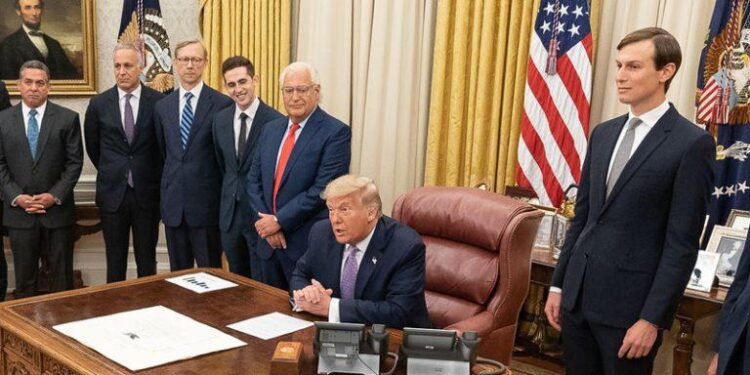The Evolving U.S. Approach to the Russia-Ukraine Conflict During Trump’s Presidency
In the intricate geopolitical arena of Eastern Europe, the ongoing conflict between Russia and Ukraine has become a central issue of global concern, capturing considerable attention from the United States and its allies. The Trump administration’s strategy regarding peace negotiations and diplomatic relations in this enduring crisis underwent significant transformations, reflecting changes in policy focus and strategic priorities. This article explores pivotal moments and decisions that influenced the U.S. position on the Russia-Ukraine situation throughout Trump’s time in office, emphasizing how diplomacy, military assistance, and broader foreign policy goals intertwined. As tensions heightened and alliances were tested, these actions not only shaped peace talks but also highlighted the complexities inherent in U.S.-Russia relations. This analysis aims to shed light on how Trump’s administration managed a crisis with far-reaching consequences for both regional stability and global dynamics.
Understanding the Initial Position: A Balance of Engagement and Caution
At the outset of Trump’s presidency, U.S.-Russia relations were marked by a juxtaposition of open dialogue aspirations against a backdrop of cautious skepticism. There was an initial push for improved ties with Russia—an idea largely fueled by Trump’s campaign promises advocating for collaborative international diplomacy. Proponents argued that constructive engagement could pave the way for meaningful discussions on critical issues like nuclear disarmament and counterterrorism initiatives.
However, this optimism was tempered by significant hesitance among key officials within his administration due to concerns over Russian aggression in Ukraine as well as interference in American electoral processes. This dual narrative complicated foreign policy efforts as differing viewpoints emerged regarding how best to approach Moscow.
The onset of discussions surrounding peace negotiations revealed internal divisions within Trump’s team; one faction emphasized national security interests, advocating for caution based on Russia’s history of deceitful behavior while another group pushed for increased diplomatic outreach with hopes that it might yield substantial progress toward resolution. These contrasting perspectives underscored not only challenges within U.S.-Russia relations but also set up a contentious policy trajectory that would evolve significantly over subsequent years.
Strategic Evolutions: Key Events That Transformed Trump’s Policy on Ukraine and Russia
The Trump administration encountered several critical turning points that redefined its approach to addressing the conflict between Russia and Ukraine. Initially focused primarily on implementing a robust sancitons regime, aimed at undermining Moscow’s economy following its annexation of Crimea in 2014, there were notable shifts during events such as July 2018’s Helsinki Summit where Trump made conciliatory remarks towards Putin—prompting backlash domestically about his commitment to NATO allies.
This created uncertainty around public perceptions concerning U.S foreign policy direction moving forward; however, as circumstances evolved so did diplomatic efforts from Washington D.C.. By late 2019 into early 2020,diplomatic dialogues witnessed renewed momentum emphasizing negotiation rather than militaristic responses—a shift exemplified through high-profile meetings with Ukrainian President Volodymyr Zelensky aimed at fostering lasting peace while managing relationships with Moscow effectively.
Additonally , significant events like impeachment proceedings initiated against him late 2019 compelled reaffirmation towards supporting Ukraine which ultimately led approval military aid packages . These instances illustrate both complexities involved along shifting strategies oscillating between confrontation versus conciliation amid rising geopolitical tensions across Eastern Europe .
Future Directions: Strategies for Enhanced U.S Engagement in Peace Negotiations
A constructive path forward regarding peace negotiations related to ongoing conflicts should prioritize several strategic objectives from American engagement perspective:
- Pursuing Backchannel Diplomacy: Establishing informal communication channels can help ease tensions while fostering trust-building measures among parties involved .
- Pursuing Multilateral Cooperation: Engaging actively through international organizations such as United Nations or Organization Security Cooperation Europe (OSCE) facilitates inclusive dialogue opportunities .
- Cultivating Clear Messaging: Transparent communication about intentions helps mitigate misunderstandings setting cooperative tone moving ahead .
Beyond enhancing diplomatic outreach , bolstering economic humanitarian support remains crucial aspect too including :
- Tailored Financial Assistance : Allocating funds directed towards recovery rebuilding initiatives post-conflict is essential .
< li >< Strong >Humanitarian Aid Expansion :< / strong > Increasing programs designed assist displaced individuals affected directly by hostilities is vital.< / li > - < Strong >Military Support Reevaluation :< / strong > Regularly assessing appropriateness military aid ensures alignment objectives promoting peaceful resolutions.< / li >
Tactic Description/Benefit Diplomatic Communication Enhancement Fostering Trust Building Efforts Economic Support Initiatives Promoting Recovery Stability Ensuring Alignment Peace Goals Conclusion: Key Insights Gained From Analyzing The Timeline Of Diplomatic Maneuvers Involving The Conflict Between Russia And Ukraine During Trumps Tenure As President Of America!
The timeline detailing how former president Donald J.Trump navigated complex dynamics surrounding ongoing disputes highlights evolving strategies policies employed throughout tumultuous period international affairs! From initial overtures leading into more skeptical stances evolution reflects broader geopolitical considerations domestic pressures faced alike! As conflicts continue unfolding implications remain significant shedding light intricate balance power Eastern European region ! Understanding historical context proves crucial policymakers analysts alike seeking lasting resolutions crises remain priority stage globally!
















![[News] Japan Develops 10nm Nanoimprint Technology, with Potential to Tackle EUV Bottleneck – TrendForce](https://earth-news.info/wp-content/uploads/2025/12/329851-news-japan-develops-10nm-nanoimprint-technology-with-potential-to-tackle-euv-bottleneck-trendforce-360x180.jpg)














